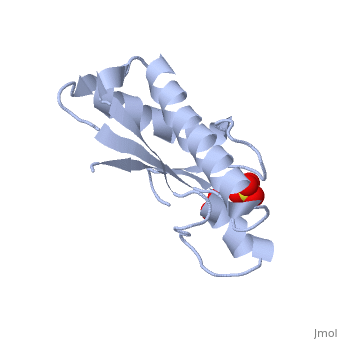Pal
From Proteopedia
StructurePal (peptidoglycan-associated lipoprotein) is a lipoprotein which is anchored in the outer membrane with an approximate length of 173 amino acids in the precursor form. It contains a signal sequence including an LVAC motif, with the flexible, hydrophobic N-terminal tail binding to the inner leaflet of the outer membrane and anchoring it. During translocation, signal peptidase II cleaves the LVAC motif, and the localisation of Pal is dependent on the Lol protein system. Serine, the amino acid at #2 position in the mature protein is a localisation determinant for the position of Pal in the outer membrane[1]. The periplasmic domain of Pal can be seen in the 3D structure 1OAP. FunctionOne of the roles of Pal is thought to be an anchor, linking the outer membrane to the peptidoglycan layer and offering support to this connection[2]. It is also possible that Pal is involved in the translocation of subunits of the surface O-antigens, affecting its structure[1]. Pal is also thought to play a significant role in the process of pathogenesis. The protein is highly immunogenic, which also makes them suitable candidates for the production of vaccines[1]. Interactions of PalDirected deletion mutagenesis was carried out to investigate the interactions of Pal with different components of the Tol-Pal system[3]:
|
| ||||||||||
3D structures of Pal
Updated on 17-April-2024
1oap - EcPal periplasmic domain - Escherichia coli
2w8b – EcPal periplasmic domain + TolB
2hqs – EcPal + TolB
2gnm, 2gnt - PaPal – Pterocarpus angolensis
1n3o – PaPal + methyl-glucose
1n3p – PaPal + sucrose
1n3q – PaPal + turanose
1q8o, 1q8p, 1q8q, 1q8s, 1qmv, 1ukg, 2ar6, 2arb, 2are, 2arx, 2gn3, 2phr, 2phw, 2phx – PaPal + oligosaccharide
4pwt – YpPal – Yersinia pestis
4r40 – YpPal + TolB
6bwl – Pal – Bacillus thuringiensis
5n2c – BcPal – Burkholderia cenocepcia
5lkw – BcPal + pimelic acid derivative
4b5c – Pal – Burkholderia pseudomallei
8yzn – Pal – Pseudomonas alcaligenes
References
- ↑ 1.0 1.1 1.2 Godlewska R, Wisniewska K, Pietras Z, Jagusztyn-Krynicka EK. Peptidoglycan-associated lipoprotein (Pal) of Gram-negative bacteria: function, structure, role in pathogenesis and potential application in immunoprophylaxis. FEMS Microbiol Lett. 2009 Sep;298(1):1-11. Epub 2009 May 21. PMID:19519769 doi:10.1111/j.1574-6968.2009.01659.x
- ↑ Parsons LM, Orban J. NMR assignment of the periplasmic domain of peptidoglycan-associated lipoprotein (Pal) from Haemophilus influenzae. J Biomol NMR. 2005 May;32(1):93. PMID:16041489 doi:10.1007/s10858-005-3676-x
- ↑ Cascales E, Lloubes R. Deletion analyses of the peptidoglycan-associated lipoprotein Pal reveals three independent binding sequences including a TolA box. Mol Microbiol. 2004 Feb;51(3):873-85. PMID:14731286

